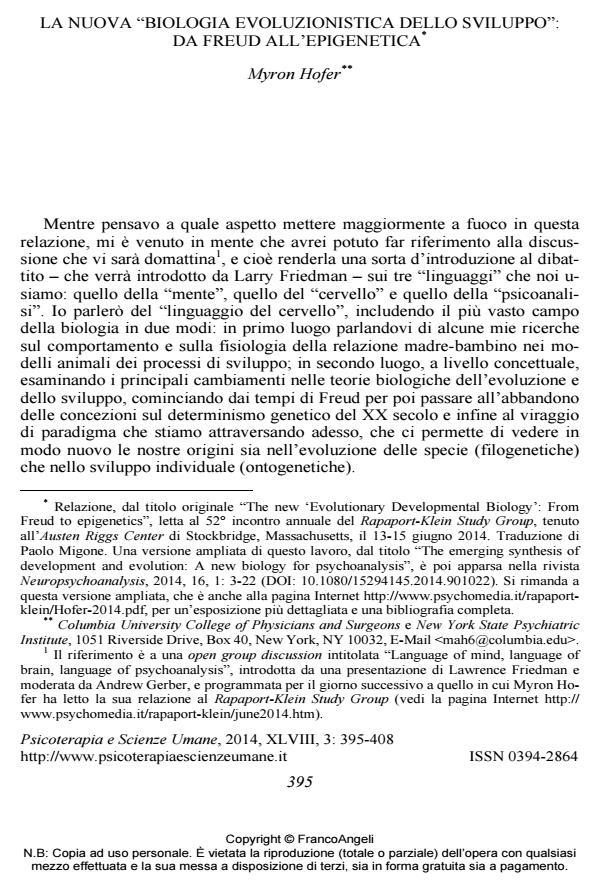The new "Evolutionary Developmental Biology": From Freud to epigenetics
Journal title PSICOTERAPIA E SCIENZE UMANE
Author/s Myron Hofer
Publishing Year 2014 Issue 2014/3
Language Italian Pages 14 P. 395-408 File size 63 KB
DOI 10.3280/PU2014-003002
DOI is like a bar code for intellectual property: to have more infomation
click here
Below, you can see the article first page
If you want to buy this article in PDF format, you can do it, following the instructions to buy download credits

FrancoAngeli is member of Publishers International Linking Association, Inc (PILA), a not-for-profit association which run the CrossRef service enabling links to and from online scholarly content.
At the end of the 19th century, evolution and development seemed closely related; at that time, the ideas of Charles Darwin, Ernst Haeckel and Jean-Baptiste Lamarck played a prominent role in Freud’s creation of psychoanalysis. But during the 20th century, as biological research reached the molecular level, evolution and development veered further from each other and further away from psychoanalysis. In the last two decades, however, developmental and evolutionary biology have come together in the creation of a new field, Evolutionary Developmental Biology ("Evo-Devo"). Recent discoveries on transgenerational effects have returned biological concepts to a closer alignment with psychoanalytic principles regarding the importance of early parent-infant interactions in the long-term development of children and of their own children. These changes are discussed through the history of the Author’s psychobiological research in the development of a relatively simple model organism, the laboratory rat.
Keywords: Developmental theory, early separation, evolution, mother-infant interaction, epigenetics
- Frailty in Children Giovanna Perricone, pp.223 (ISBN:978-3-031-24306-6)
- Perché abbiamo bisogno degli oggetti? Uno studio di psicoanalisi comparata Morris N. Eagle, in PSICOTERAPIA E SCIENZE UMANE 4/2014 pp.577
DOI: 10.3280/PU2014-004002 - Epigenetica e psiconeuroimmunoendocrinologia: una rivoluzione che integra psicologia e medicina Francesco Bottaccioli, in PSICOTERAPIA E SCIENZE UMANE 4/2014 pp.597
DOI: 10.3280/PU2014-004003 - Come gli stati psichici si traducono in molecole biologiche e come questo cambia la medicina e la psicologia Anna Giulia Bottaccioli, Francesco Bottaccioli, in PSICOTERAPIA E SCIENZE UMANE 1/2023 pp.107
DOI: 10.3280/PU2023-001012
Myron Hofer, La nuova "biologia evoluzionistica dello sviluppo": da freud all’epigenetica in "PSICOTERAPIA E SCIENZE UMANE" 3/2014, pp 395-408, DOI: 10.3280/PU2014-003002